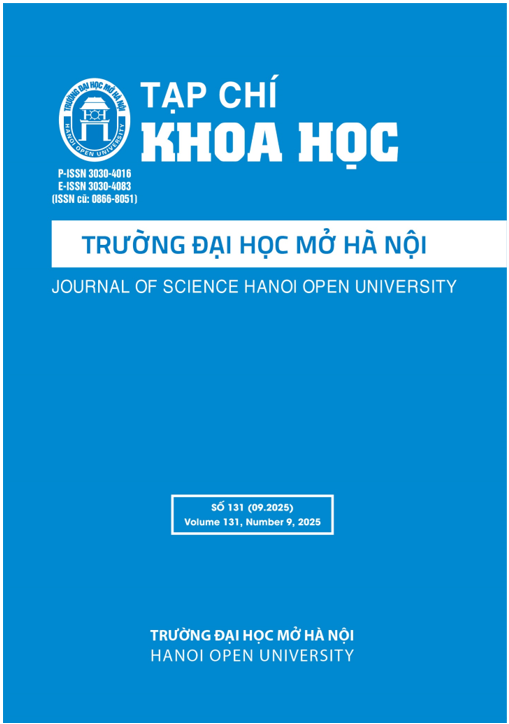FACTORS AFFECTING STUDENTS' SATISFACTION WITH THE TRAINING QUALITY AT CAN THO TECHNICAL ECONOMIC COLLEGE
DOI:
https://doi.org/10.59266/houjs.2025.747Keywords:
Economics college, quality, satisfaction, students, trainingAbstract
This article analyzes the factors affecting students' satisfaction with the training quality at Can Tho Technical Economic College. The research data was collected through a survey of 180 students currently studying at the college. Methods used in the study include reliability testing of the measurement scales using Cronbach's alpha coefficient, exploratory factor analysis, and multiple linear regression analysis. The results reveal that factors influencing students' satisfaction with the college's training quality include Institutional Reputation and Credibility, Facilities and equipment, Training program, and Faculty quality. Among these factors, faculty quality is the most influential factor affecting students' satisfaction with training quality.
References
[1]. Alves, H., & Raposo, M. (2007). Conceptual model of student satisfaction in higher education. Total Quality Management, 18(5), 571-588. https://doi.org/10.1080/14783360601074315
[2]. Astin, A. W. (1999). Student involvement: A developmental theory for higher education. Journal of College Student Development, 40(5), 518-529.
[3]. Brown, R. M., & Mazzarol, T. W. (2009). The importance of institutional image to student satisfaction and loyalty within higher education. Higher Education, 58(1), 81-95. https://doi.org/10.1007/s10734-008-9183-8
[4]. Chen, Y. F., & Hsiao, C. H. (2010). Antecedents and consequences of the perceived quality gap in higher education: A case study of a business school. Total Quality Management & Business Excellence, 21(11), 1147-1160. https://doi.org/10.1080/14783363.2010.487680
[5]. Cheng, Y. C., & Tam, W. M. (1997). Multi-models of quality in education. Quality Assurance in Education, 5(1), 22-31.
[6]. Firdaus, A. (2005). HEdPERF versus SERVPERF: The quest for ideal measuring instrument of service quality in the higher education sector. Quality Assurance in Education, 13(4), 305-328. https://doi.org/10.1108/09684880510626584
[7]. Hair, J. F., Black, W. C., Babin, B. J., & Anderson, R. E. (2014). Multivariate data analysis (7th ed.). Pearson Education Limited.
[8]. Harvey, L., & Green, D. (1993). Defining quality. Assessment and Evaluation in Higher Education, 18(1), 9-34.
[9]. Herzberg, F. (1966). Work and the nature of man. World Publishing Company.
[10]. Hill, Y., Lomas, L., & MacGregor, J. (2003). Students’ perceptions of quality in higher education. Quality Assurance in Education, 11(1), 15-20. https://doi.org/10.1108/09684880310462047
[11]. Kano, N. (1984). Attractive quality and must-be quality. Journal of the Japanese Society for Quality Control, 14(2), 39-48.
[12]. Kirkwood, A., & Price, L. (2005). Learners and learning in the twenty‐ first century: What do we know about students’ attitudes towards and experiences of information and communication technologies that will helpusdesigncourses? Studies in Higher Education, 30(3), 257-274. https://doi. org/10.1080/03075070500095689
[13]. Kuh, G. D. (2003). What we’re learning about student engagement from NSSE: Benchmarks for effective educational practices. Change: The Magazine of Higher Learning, 35(2), 24-32. https:// doi.org/10.1080/00091380309604090
[14]. Nguyen, T. H., & Pham, M. T. (2022). Improving training quality in Vietnamese vocational education: Challenges and solutions. Journal of Educational Management, 14(2), 45-58.
[15]. Nguyen, D. T. (2011). Phương pháp nghiên cứu khoa học trong kinh doanh (Lần tái bản thứ 2). NXB Lao động - Xã hội.
[16]. Nguyen, T. M. T., Nguyen, D. T., & Mai, L. T. V. (2008). Các yếu tố chính tác động vào kiến thức thu nhận của sinh viên khối ngành kinh tế tại TP. HCM (Đề tài B2007-76-05). Bộ Giáo dục và Đào tạo.
[17]. O’Neill, G., & Palmer, A. (2004). E-learning in tertiary education: Where do we stand? Higher Education Research & Development, 23(2), 221-236. https://doi. org/10.1080/0729436042000206729
[18]. Palacio, A. B., Meneses, G. D., & Pérez, P. J. P. (2002). The configuration of the university image and its relationship with the satisfaction of students. Journal of Educational Administration, 40(5), 486-505. https:// doi.org/10.1108/09578230210440311
[19]. Parasuraman, A., Zeithaml, V. A., & Berry, L. L. (1988). SERVQUAL: A multiple-item scale for measuring consumer perceptions of service quality. Journal of Retailing, 64(1), 12-40
[20]. Soutar, G. N., & Turner, J. P. (2002). Students’ preferences for university: A conjoint analysis. The International Journal of Educational Management, 16(1), 40-45. https://doi.org/10.1108/09513540210418403
[21]. Tang, K. H., & Zairi, M. (1998). Benchmarking for quality in higher education: Student perspective. Total Quality Management, 9(6), 439-452. https://doi.org/10.1080/0954412988325
[23]. Tinto, V. (1993). Leaving college: Rethinking the causes and cures of student attrition (2nd ed.). University of Chicago Press.
[24]. Tran, N. M., Nguyen, T. T. T., & Nguyen, H. M. T. (2021). Các nhân tố ảnh hưởng đến chất lượng đào tạo của Khoa Ngoại ngữ, Trường Đại học Sài Gòn. TNU Journal of Science and Technology, 226(04), 43-52.
[25]. Vo, T. Q., Pham, X. L., & Doan, T. C. (2015). Kiểm định thang đo chất lượng đào tạo bậc Đại học trên góc độ sinh viên - Một nghiên cứu tại TP.HCM. Tạp chí Khoa học Trường Đại học Mở TP.HCM, 10(2), 185-198
